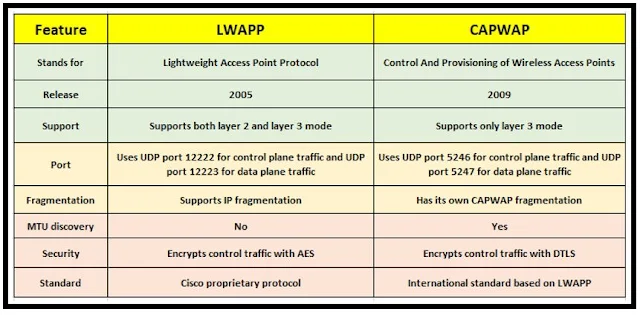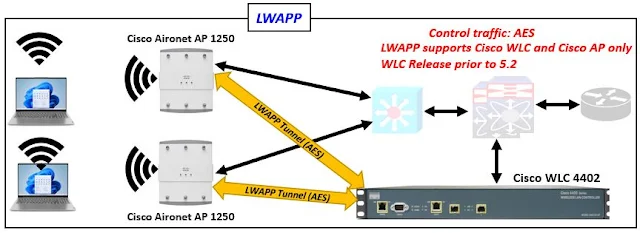LWAPP Vs CAPWAP
LWAPP Vs CAPWAP
Lets talk about these both protocols used in Wireless environment. Before we will talk about the difference between these protocols, first let introduce them
⭐ What is Lightweight Access Point Protocol (LWAPP) ?
LWAPP stands for Lightweight Access Point Protocol, which is a Cisco proprietary protocol that defines the communication between wireless access points and wireless LAN controllers. LWAPP allows the controllers to manage the configuration and operation of the access points, as well as the encryption and authentication of wireless clients
LWAPP may operate in either Layer 2 or Layer 3 transport modes. Layer 2 LWAPP communications are contained in Ethernet frames and designated with the EtherType code 0x88BB. Layer 2 LWAPP mode of operation is not routable due to Ethernet dependability and requires Layer 2 visibility between WLCs and APs.
Layer 2 is deemed defunct, and the protocol data shown in this traffic research are based on the Layer 3 LWAPP transport mode. Layer 3 LWAPP transport mode describes how LWAPP messages are exchanged across the IP network in the form of UDP-encapsulated packets. The LWAPP tunnel is maintained using the IP addresses of the WLC (ap-manager) interface and the AP.
LWAPP, a Cisco proprietary protocol, has been replaced by the international standard CAPWAP (Configuration and Provisioning of Wireless Access Point). Wireless LAN Controllers/WiSM running firmware 5.X or later support CAPWAP. The 3.X and 4.X firmware are LWAPP.
⭐ What is CAPWAP ?
CAPWAP, or Control and Provisioning which is a standard protocol that defines the communication between wireless access points and wireless LAN controllers CAPWAP is intended to help manage and control many APs via a central controller.
For more details on CAPWAP, please check below article
⭐ What is CAPWAP vs LWAPP ?
CAPWAP is based on LWAPP, however there are several significant variations to consider. The CAPWAP discovery technique is considerably more effective than LWAPP. Dynamic MTU is a feature of CAPWAP that improves communication between the controller and network.
The key difference is L2/L3 mode support and the Security feature they used.
 |
| Fig 1.2- LWAPP Vs CAPWAP |
In Summary, LWAPP is now absolute technology and no more used. CAPWAP is more advanced with DTLS security which is now a trend for security tunnels to connect endpoints.
Continue Reading...










